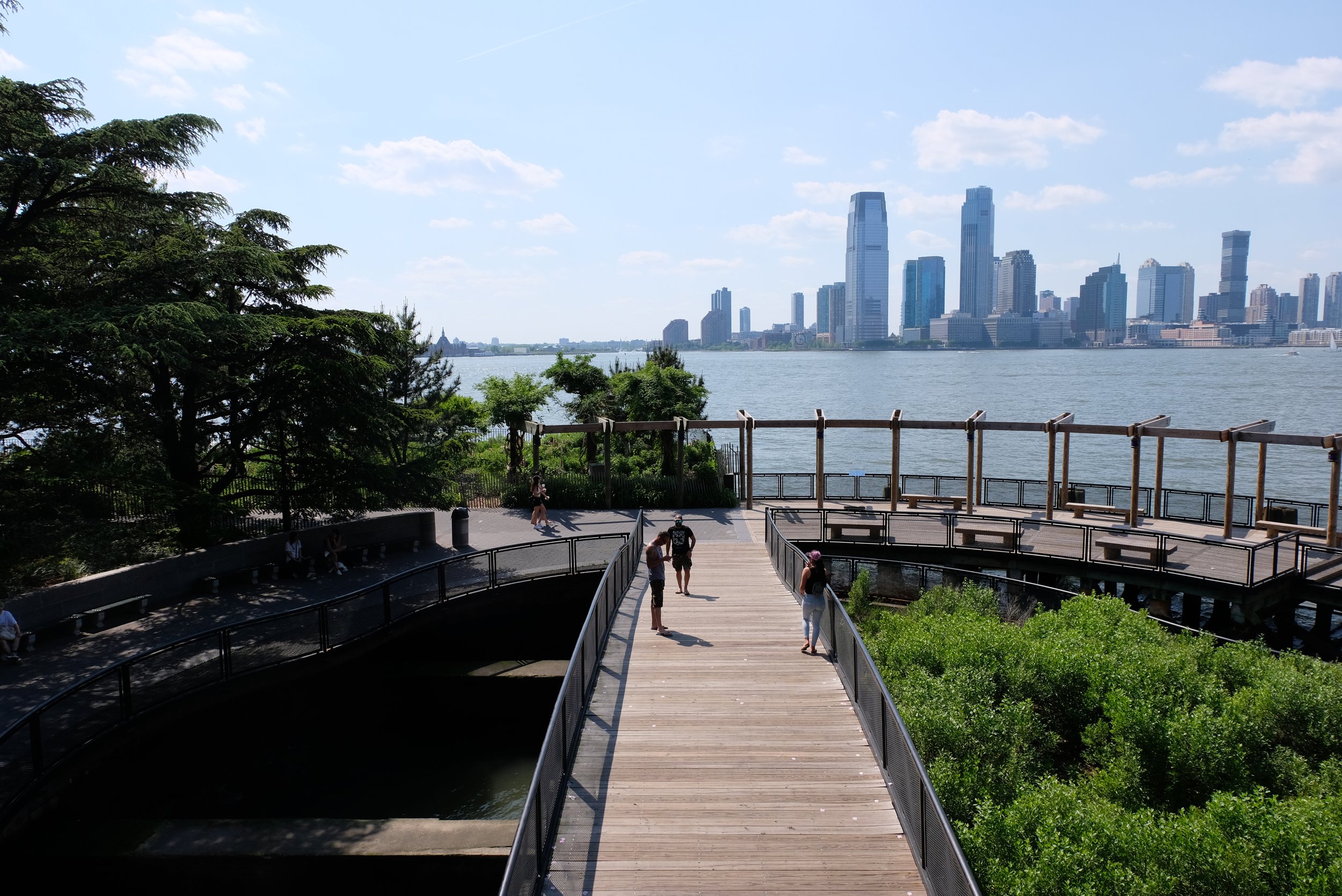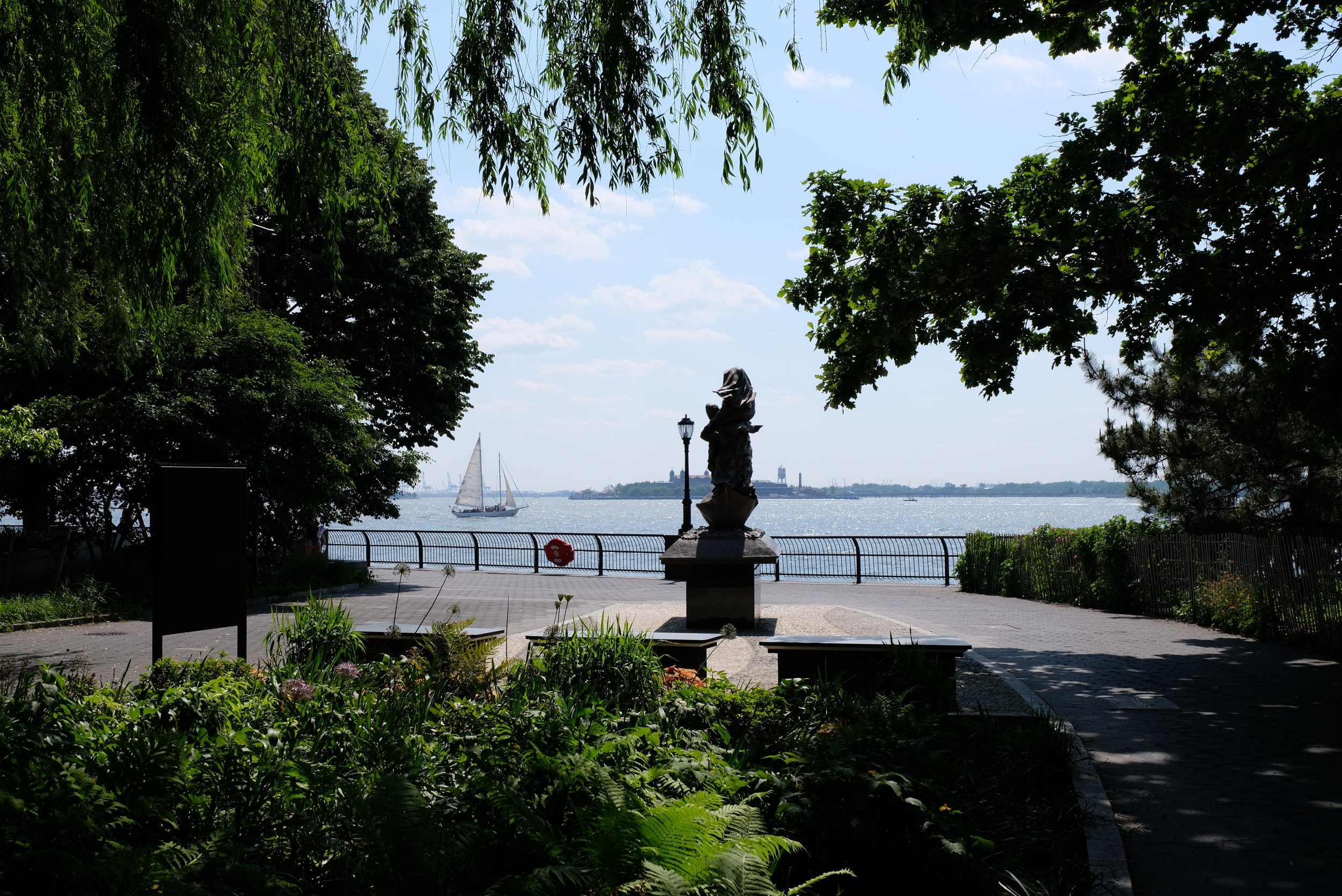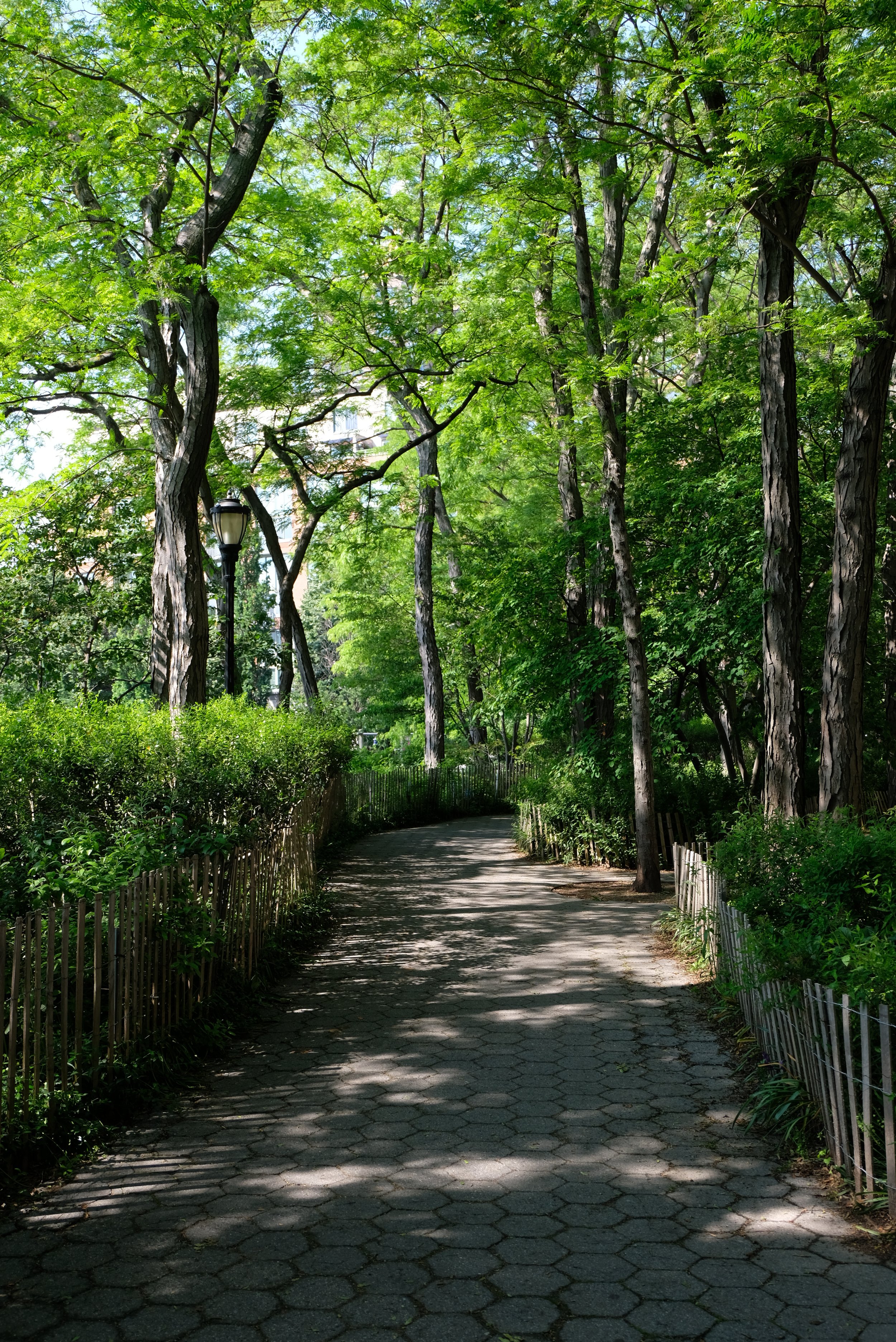About.
When standing in the middle of South Cove Park, it’s hard to believe that you’re just a short walk away from the hustle and bustle of Wall Street. Not only are the surroundings serene and relaxing, but the sparsely populated area is often entirely devoid of ties and suits. Perhaps one or two of the brokers may choose to occasionally lunch in this place. But on the whole, it’s something improbable: An area of great beauty in NYC that has not been overrun.
As for South Cove Park South Cove proves that it’s possible to find a hidden gem even within one of the most densely populated places on Earth. That this particular hidden gem just so happens to be incredibly beautifully designed is another great plus.
Anyone visiting South Cove Park should begin by standing at the end of Hudson Greenway and gazing at one of the best views of the One World Trade Center. This gives an impression of what South Cove Park may be like if it were more typical of what people think of New York City. Tourists and locals jostle back and forth on the sidewalk as yellow cabs search for customers by crawling along the edge of the road. Then, by turning left and walking alongside the coast through Robert F. Wagner Jr. Park, the visitor feels the city fade away. Out in the harbor, the Statue of Liberty is visible. On the opposite side, the top of the Freedom Tower still peaks out over the closer high rises, reminding visitors that this is still New York, even if it doesn’t feel like it. The perfectly tended lawns and landscaping surrounding the Jewish Heritage Museum lead into South Cove Park itself, offering a perfect segue from downtown to seclusion. Lastly, just before the entrance to the park, is the dignified statue of Mother Cabrini looking out toward Ellis Island, as if guarding the park against the excesses of city lifestyle.
As for South Cove Park itself, it’s hard to believe that it was constructed decades after the death of Frederick Law Olmstead, the visionary behind Central Park and Prospect Park. Instead, in the 1980s, the Battery Park City Authority commissioned a woman-led team to create this oasis of peace. Amazingly, South Cove Park avoids the garishness of the 1980s. Instead, it has the sparse, deliberate feel of Central Park’s calming layout. This all comes together perfectly within the main circle of the park, where brick paths turn into wooden walkways. This circular design stretches over the Hudson River itself, forming an esplanade lined with wooden pilings, with tree branches wrapping over them. And then, the walkway abruptly tops, but the pilings do not. Instead, the frame of the esplanade extends a few feet further, almost but not quite reaching the solid ground. Anyone who has previously used the golden ratio in their work and who has followed this esplanade to its end point will realize that they’ve just walked through a manifestation of this timeless aesthetic and geometric tool. An elevated platform situated over the land-based portion of this circular center allows visitors to gain an even better view of the stunning surroundings and ponder how this idyllic setting isn’t overflowing with tourists.
Behind this platform, the park becomes denser, with plants, trees and rocks slowly filling more space. As many have noted before, South Cove Park doesn’t feel cluttered, yet paradoxically contains some of the most impressive willow trees situated in Lower Manhattan. This creates the effect of making the park look as if nature has shaped the cove, with the plant life and rock formations being more prominent the further they are from the water. Of course, this is a design choice, but it’s not immediately obvious to those walking through the grounds. This gives visitors an almost subliminal impression of this beautiful area being sculpted by Mother Nature herself, with humans merely choosing to enhance the surroundings with platforms and pilings.
While the park is the most immediately notable part of South Cove, the buildings bordering it are also an important aspect of this area. These buildings are primarily for residential purposes, and they’re a lot smaller than the skyscrapers that Downtown is known for. Instead, these brick apartment complexes are mostly around 10 stories high. No one building is exactly like the other, but, in a way that’s typical of New York, their superficial differences coalesce into a unified whole. Really, these structures highlight how the city seamlessly blends styles and cultures in a way that couldn’t work in most other locations. The lower size of these buildings also aids the calming nature of the park they border. Instead of imposing upon the space, their smaller stature creates a gradient thanks to the lower trees in front of them and the skyscrapers beyond.
The building that most perfectly typifies South Cove is the aptly named South Cove Plaza. This nine-story building was completed in the year 1999 and is filled with luxurious touches, such as parquet flooring. This building houses some of the most successful individuals to live in New York City. The deluxe nature of this building is reinforced with a few clear signs of extravagance. For instance, it’s common to see sports cars parked nearby.
The “hidden gem” nature of South Cove is fantastic for those who use it regularly. But it’s also a shame that more people don’t appreciate the fantastic work of all those who have crafted such a perfect area. Those who were involved in the construction of South Cove need to be appreciated for what they have created. Three people, in particular, were instrumental in South Cove’s creation: Susan Child, Mary Miss and Stanton Eckstut.
The Cultural Landscape Foundation describes South Cove as Susan Child’s magnum opus. When Child was commissioned to create South Cove Park in the 1980s, she was still a relatively unknown name in the landscape architecture field. Child had studied art history and French when she attended Vassar College in the 40s and 50s. For the next 20 years, she immersed herself in all forms of artistic expression before realizing that one of her favorite hobbies, gardening, was where she could have a lasting impression. She then used her talents to transform vacant areas of Boston into stunning green spaces. To improve her craft, she enrolled in the Landscape Architecture program at Harvard University, graduating in 1981. Clearly, Child’s combination of hands-on experience and world-class training was put to good use when it came to South Cove Park.
Stanton Eckstut is the architect who designed the master plan for Battery Park City, which South Cove lies within. This plan would result in Eckstut winning the American Institute of Architect’s Citation of Excellence Honor Award in 1990. Since this time, he has gone on to win five more prestigious awards for his work. Clearly, for the South Cove Park area, Eckstut realized that he needed to collaborate with equally gifted artists.
Mary Miss pioneered the land-art movement in the 60s and 70s. Her approach to environmental artwork is to use the history and ecology of public settings to inform design decisions, blending aspects of architecture, sculpture, landscape design and installation art. She summarizes this framework as the “City as a Living Lab” approach to urban design.
To create South Cove Park, Child, Eckstut and Miss were challenged with using what was excavated from the former construction sites of the World Trade Center Twin Towers. The designers realized that this material would have to transform the sandy banks of what was then neglected land. Often, when three artists of varying backgrounds and approaches try to collaborate, the sum becomes less than its parts, resulting in an inferior final product. With South Cove Park, the opposite happened. It’s impossible to tell where one artist’s input ends and the others’ begin within this space.
Mary Miss had no way of knowing it at the time, but this would not be the last time that she created a work of significant cultural importance that was heavily associated with the Twin Towers. In 2002, after witnessing the horrors of September the 11th and noticing passersby using the barriers of the site as a pilgrimage spot, she collaborated on another project, Moving Perimeter: A Wreath for Ground Zero. This temporary installation sought to enhance the ways in which people paid their respects to those who had suffered and lost their lives as the land was reconstructed, with fencing, seating, planting and floor paintings all being used to create beauty out of tragedy in a respectful, somber way.
A detailed look at South Cove Park reveals just what inspired these artists. For example, lined above the elevated platform is a metal crown. Taken on its own, this metal crown looks impressive, but it seems to be at odds with a park where nature takes precedence. But then it becomes clear that this is a reference to a nearby landmark. This crown represents the crown at the top of the Statue of Liberty. When this comparison is made, then the reason for the crown’s inclusion is clear. The Statue of Liberty famously has inscribed within its base the poem The New Colossus, with these words being the most often requoted: “Give me your tired, your poor, Your huddled masses yearning to breathe free, The wretched refuse of your teeming shore.” Therefore, the crown highlights the importance of spaces like South Cove Park within all neighborhoods. After all, parks are for the masses, and those that design parks often feel strongly about creating a space that’s for everyone, not just the privileged few. What could be a better way of highlighting this fact than by paying homage to a monument that’s synonymous with American ideals?
Many may wonder if, after 35+ years, South Cove Park still manages to look as impressive as it first did. Several years ago, the park was showing signs of disrepair, especially the esplanade’s decking and piling sections. But the Battery City Pak Authority took it upon themselves to right this wrong. They commissioned the planning, design, environmental and construction support services consulting firm Urban Engineers to undertake a careful and faithful restoration of the space. Urban Engineers faced a significant challenge in ensuring that the park retained its character, as many of the original plans that went into the project were missing. However, as any comparison of before and after pictures proves, this renovation was a complete success. The esplanade retains the same design as it originally had, with new decking mimicking the original timber perfectly, at least on a visual level, with structural enhancements lying within. Now, the walkway looks as fresh as it first did, and the metal railings glimmer in the sun, as they should.
As much of South Cove is a park and apartment complexes, the dining options within this area are sparse. However, it is just a few minutes away from some of the best restaurants that New York City has to offer. Many of these restaurants pre-date South Cove. Definitely the most unique nearby dining experience is Trinity Place Bar & Restaurant, located just over half a mile away on 115 Broadway. What makes this specific dining option so special is its setting. Guests get to dine within an old bank vault that dates to the early 20th century. The original owner of the bank was none other than Andrew Carnegie, the man who built the world famous Carnegie Hall and who pioneered modern philanthropy. As can be expected for a restaurant with such a location, the food is expensive but undeniably worth it, with highlights being house made chicken liver pate, confit duck leg risotto and the Trinity Wagyu Burger.
Another fantastic dining spot nearby South Cove is Bobby Van’s Steakhouse, located at 25 Broad Street. The original Bobby Van’s Steakhouse opened in 1969 in The Hamptons and hosted some of history’s greatest artists, celebrities and politicians. The Broad Street location opened in the 1990s. There’s no prize for guessing the stand out item on this restaurant’s menu (hint: there’s a clue in the title.) But a number of other dishes compliment the restaurant’s prime offering, such as the Colossal Lump Crab Cocktail, the salmon sushi roll and the toasted parmesan gnocchi.
An even closer fine-dining option is Gigino at Wagner Park, located just 0.2 miles south of South Cove Park. In fact, this restaurant is so close that it shares many of the same views as South Cove Park, including the Statue of Liberty, Ellis Island and the One World Trade Center. Gigino’s at Wagner Park is an Italian restaurant, with many of the classic items, such as antipasti, pasta and tiramisu. Naturally, for a restaurant by the water, its seafood selection makes it stand out. In fact, it offers three different mussel dishes, three different salmon dishes and four different shrimp dishes on its regular menu.
Downtown Manhattan is one of the best places to access public transportation within New York City. The many subway stations near South Cove highlight this perfectly. Within 0.3 miles of South Cove are the 1 train Rector Street; R, W Rector Street; and 4, 5 Bowling Green stations. Naturally, these subway lines run the length and breadth of four out of five boroughs of the city, either allowing commuters to travel through Manhattan to the top of the Bronx, the bottom of Brooklyn or the edge of Queens.
South Cove is also situated near a number of educational institutions, including the New York Film Academy, Nyack College, Metropolitan College of New York and The King’s College. All of these places of learning have campuses within half a mile of South Cove. Similarly, the aforementioned Musuem of Jewish Heritage, the Skyscraper Museum, the National Museum of the American Indian and the Alexander Hamilton US Custom House are located less than 0.4 of a mile from South Cove. This highlights how, in many ways, the Battery Park region that South Cove belongs to is more varied than many believe. Downtown Manhattan will likely always be associated with the capital of the financial world. But it’s also a place where students come to pursue degrees, where people engage with their heritage and where people come to learn about the history of the USA.
As with every location in New York City, South Cove will offer something unique to everyone who comes to visit. Even within a place as secluded as South Cove Park, interesting things happen all the time. For example, in the past, the Battery Park City Authority has organized free draw in the park sessions, and countless people must have chosen this place as the spot to propose to their partners. Through all of this, South Cove Park will continue to be a stunning, special place for those who seek it out.











